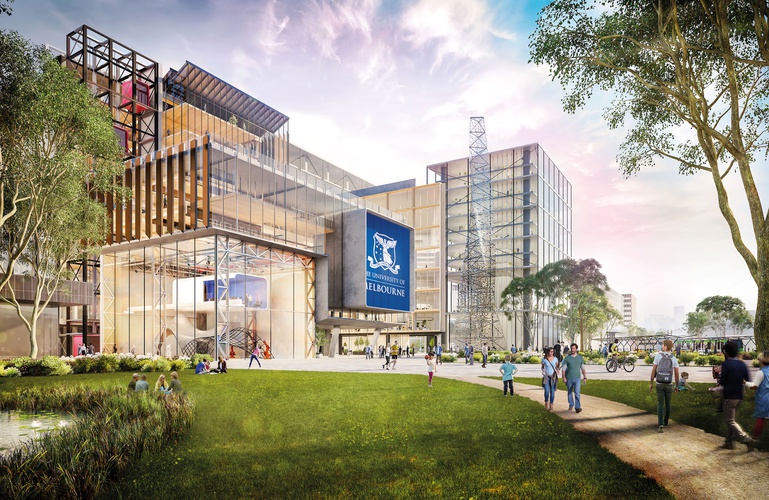Five minutes with Dr Gerard Healey
25 Nov 2021
Green Star Buildings is built for industry, by industry and has already been tested by a range of early access partners, including the University of Melbourne’s Fishermans Bend campus. We spent five minutes with Dr Gerard Healey, Green Star Champion and the University’s Manager, Estate Performance and Sustainability, to find out how Green Star Buildings is helping the University push boundaries.
1. Fishermans Bend campus will incorporate Green Star rated buildings within a Green Star rated community. Why was Green Star the choice for this city-changing precinct?
Our sustainability target for the Fishermans Bend campus is to make an impact, both on our campus and beyond. We aim to push the boundaries with innovative and exemplary standards for water, energy and carbon emissions, and waste, while driving the industry forward through demonstration, research, partnerships and hands on educational experiences.
Participating in the Early Access Program with Green Star Buildings is one way we can extend our impact beyond the boundaries of the campus. By engaging with and potentially influencing the new rating tool we can test ways for Green Star rated buildings to go even further in the future. By rating our buildings using the tool, we can demonstrate ways to improve outcomes using a framework and language that is relevant to and readily understood by the Australian property sector. This will help industry evolve to meet the sustainability challenges of the next decade.

2. You’ve had the opportunity to apply our new tool, Green Star Buildings, to the project. What challenges have you learned from along the way?
Our project is in schematic design, so to date the team has applied the tool more broadly, starting with outcomes and aligning to the broader project goals. A few challenges have become apparent, including:
- Greening of urban infill and hitting biodiversity targets has pushed the team to extend greening vertically and over rooftops.
- Reducing stormwater discharge volume of 40-80% is challenging on a site that has a high water table and affected by flooding and storm surge.
- Capturing opportunities and managing risks around responsible products, particularly without a head contractor on board yet. Careful thought is required to balance clear project sustainability requirements vs enabling and incentivising potential head contractors to bring their expertise and innovation to the project through the tendering process.
- Many parts of the project are industrial in nature, such as fabrication workshops, engine test labs etc. Achieving good indoor environment quality, particularly thermal comfort and acoustics, is inherently challenging.
3. Do you have any tips for project teams transitioning from Green Star Design & As Built to Green Star Buildings?
Because we are part of the Early Access program, our ESD consultant for the project, AECOM, is helping us seek dual ratings under Design & As Built and Buildings. They have made the following observations and suggestions:
- Whilst there are some similarities, there are many differences, so get the project team on board and engaged around the initiatives as soon as possible.
- The reframing of the categories in the Buildings tool enables clearer links to beneficial outcomes for project stakeholders and the University, and this has had a positive influence on how the project team has engaged with the tool.
- Buildings has more focus on procurement than previous tools, so working effectively with the head contractor will be imperative to achieving outcomes. As noted previously, careful thought is required about how sustainability requirements are specified during tender so that the University can set clear requirements, but also incentivise contractors to bring their expertise and innovation.
4. You’ve described the Fishermans Bend Campus as a “living lab for sustainable development”, how has Green Star Buildings helped you innovate?
From the outset, innovation has been a key aspiration of the new campus. The University of Melbourne’s purpose is to benefit society through the transformative impact of education and research. One manifestation of this is our aspiration to be leaders for a sustainable future – through education and research, through our campuses and their operations, through partnerships and in the development of precincts intertwined with the city. The new Fishermans Bend Campus will put this aspiration into practice.
My favourite definition of innovation is: something new that adds value. Green Star, along with our Engineering and Architectural Design Guidelines for the campus, help us ensure that new things add value, for example by providing a framework to discuss potential innovation, adding rigour to claimed / expected benefits, and providing a common language between the design team, Faculty project stakeholders and contractors.

5. How do you hope Green Star Buildings will change Australia’s built environment?
I hope that Green Star Buildings and the Fishermans Bend Campus will have a few key impacts on Australia’s built environment.
- Accelerate decarbonisation in materials, construction and operations. The University recently announced climate change targets, including an aim to be a climate change leader. This means that through sharing our own experiences and achievements we will be able to help others move sooner, faster and/or more effectively to decarbonise their own activities than they otherwise would. I expect Green Star Buildings will be an important vehicle to help us share our experiences.
- While noting that reducing carbon emissions is critical, it is not the only sustainability issue relevant to the built environment. I hope that Green Star Buildings, with its new category framework, encourages more holistic considerations.